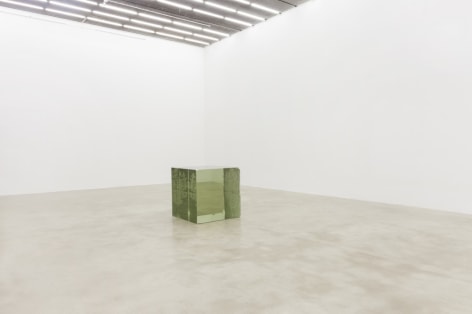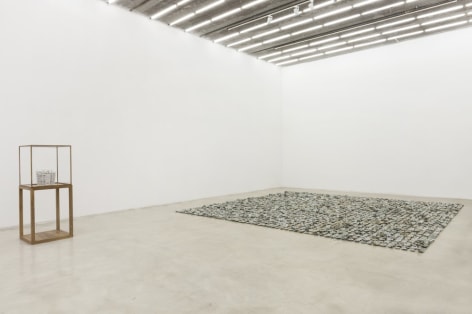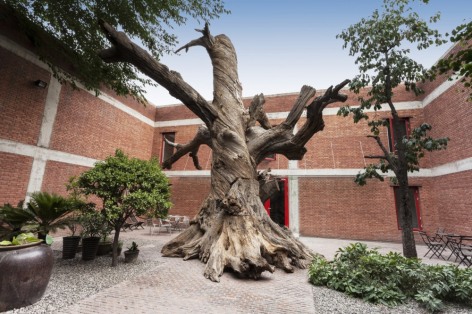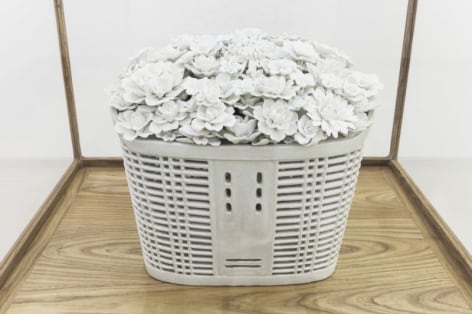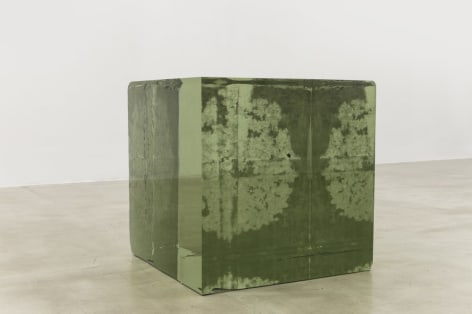From June 13, 2015 Chambers Fine Art will be hosting Ai Weiwei: Tiger, Tiger, Tiger, an exhibition that reveals in dramatic form the different approaches he adopts in the shaping of the materials with which he works, in this case wood, crystal, and porcelain. Appropriately this installation will take place at Chambers Fine Art in Red No. 1 D in the Red Brick Art Gallery complex in Caochangdi he designed in 2007.
As visitors approach the gallery, they will be confronted by a massive tree in the center of the courtyard that contrasts with the living specimens that dominate it at present. For many years Ai had been collecting wooden beams and pillars from disused Ming and Qing dynasty temples for use in his own work and in 2009 he began acquiring dead wood from mountain ranges in Jiangxi that led to the creation of a spectacular series of sculptural trees.
In complete contrast to the elegant simplicity of Ming dynasty furniture, there is a long tradition in China of fabricating furniture and decorative objects from naturally contorted wood. Ai carries this to a new level, using traditional wood assembly methods to assemble branches, roots and trunks of unrelated trees into hybrid forms that commemorate the strength and endurance that enabled them to survive for hundreds or perhaps even thousands of years. The tree on display in Chambers’ courtyard is one of the most dramatic of the entire series, extravagant in its piling up of writhing forms that resemble the coiling dragons that feature so prominently in the Chinese imagination.
In complete contrast are the two works inside the gallery, one minimal in form, the other comprising approximately 3,500 porcelain shards. Ai first used crystal as a material in 2002 in Chandelier, the work he submitted to the 2002 Guangzhou Triennial. This consisted of thousands of small, faceted crystal forms assembled in the shape of a giant chandelier and offering a pointed commentary on the excesses of contemporary, nouveau-riche interior decoration, but in the series of crystal cubes the material is presented as solid blocks of unprecedented scale. Formally, they descend from American minimalism of the 1960s and are a continuation of Ai’s one -cubic meter series which include Ton of Tea, Cube in Ebony and Marble Cube but the transparent nature of the material results in disorienting spatial effects. In whatever medium he works, Ai challenges formerly accepted limitations in the handling of materials, never more so than in the series of crystal cubes that challenge the skills of the glass-making professionals and frequently end in failure.
While the crystal cube is a fabricated object, Tiger, Tiger, Tiger consists of approximately 3,000 porcelain shards, each of which bears an image of a tiger painted in a wide variety of styles. Laid side by side on the floor, this variegated carpet of blue and white porcelain shards conflates Ai’s love-hate relationship with the ceramic traditions of China and his love of cats, a considerable number of which roam at liberty in his home and studio. Since 1994 when he first dropped a Han dynasty urn, he has investigated notions of authenticity, antiquity, and value in a challenging series of works which have involved fabricating, shattering, pulverizing, and covering ancient vessels with house-paint. Although generally regarded as an iconoclast, there is a sense in which Ai is also a committed conservationist, giving new value to discarded structural elements from Ming and Qing dynasty temples in his sculptural works, reconstructing the Ming dynasty ancestral hall currently on view in the 798 Art District and now with Tiger, Tiger, Tiger, giving metaphorical meaning to thousands of shards that have great interest for scholars but are of limited appeal to the general public. Rescued from oblivion and laid out with the greatest care, the shards are utilized in the creation of a floor-hugging sculpture that simultaneously permits observation of the differences and resemblances between the component parts and reflection on the cultural and technological achievements of China in previous centuries. In this respect it is a continuation of the methodical procedure he followed between 1993 and 2000 in assembling the 3,600 Neolithic stone tools that constitute the work Still Life.
In recent years Ai’s work has been the subject of numerous international exhibitions but Chambers Fine Art is particularly proud to be exhibiting his work in Caochangdi, the area that since 1999 he has transformed through his significant architectural practice.
前波画廊将于2015年6月13日起举办题为《艾未未: 彪》的展览。此次展出的作品分别以木质、水晶和陶瓷为创作媒材,生动地展现出艺术家风格迥异的创作手法。与此同时,此次展览将在由艾未未本人于2007年设计的草场地红砖房红一号D座北京前波画廊举行,可谓是择木而栖。
当观者来到画廊,首先进入眼帘的将是庭院中央的一棵参天大树,与院中已有的自然生长植物形成对比。多年来,艾未未一直在搜集明清时期寺庙里废弃的木头梁柱,并将其作为创作的媒介。2009年起,他开始收集在江西山区枯死的古树,并以此创作了一系列树雕。
中国自古以来就多用扭曲多节的树枝和树根制作和装饰家具,这一传统与明代家具的典雅古朴风格截然不同。艾未未将这一传统工艺提升到一个新的高度,运用传统的木工隼卯技术,将不同古树的树枝、树根和树干混合,组装成全新的整体,以向千百年的老树顽强和坚韧的生存力致敬。前波画廊庭院中展出的这棵树是整个系列中最震撼和引人注目的一件。枝蔓连绵缠绕的形态栩栩如生,勾勒出中国文化中所熟知的蟠龙形象。
另外两件在室内,一件形态极简,另一件则由3000多件陶瓷碎片组成。在2002年广州三年展中,艾未未的作品《水晶灯》首次使用水晶作为媒介,这是由数千个多面小水晶组装而成的一个巨型吊灯,该作品对当代暴发户式的室内装饰提出了尖锐的质疑。在这次展出的水晶立方作品中,水晶这一材料以空前的规模呈现出来。从形态上来说, 它延续了美国60年代的极简主义风格。同时,它也继续了艾的一立方米系列如《一吨茶》、《黑檀木立方体》和《大理石立方体》。与以前材料不同的是,水晶剔透晶莹的自然特性造成了令人迷惑的空间错位效果。无论艾用什么媒材进行创作,他都会向墨守陈规的传统工作方式进行质疑,并尝试突破其局限性。而水晶立方就是最好的例子,其制作过程常常以失败而告终,对专业玻璃工匠的技艺充满挑战。
与制造出的水晶立方不同,《彪》由3025个陶瓷碎片组成,每个陶瓷碎片均有风格迥异的虎的图像。它们经过精心排列而整齐有序地置放于地面上,仿佛是一张由青花瓷碎片编织而成的地毯。这件作品将艾未未对中国传统陶瓷工艺的爱恨交加,以及对伴随左右的猫的钟爱,巧妙地结合在一起。从1994年第一次摔碎汉代瓦罐开始,他在一系列作品中仿造、破坏、粉碎及用家用油漆去覆盖古代瓦罐,以探讨真伪、古迹以及价值体系等多重问题。尽管艾未未通常被认为是一个反传统的人,但他的艺术创作又反映出他对传统文化的珍惜和保护,在艾的雕塑作品中,将废弃的明清建筑素材赋予了新的价值,比如在近期798艺术区重建的明代祠堂。同时《彪》这件作品将注意力集中到深受学者关注却不被众人瞩目的陶瓷碎片。这些遭世人遗忘的陶瓷碎片被发掘出来并小心翼翼地铺在地上,形成一件与地相连的雕塑作品。观者在仔细观察各组成部分之间的差异和相似之处的同时,也可以思考过去几百年来中国文化与工艺之大成。这一作品同时也延续了他在1993-2000年间创作、由3600个新石器时代的石制工具组成的《静物》的系列创作方式。
近年来,艾未未在世界各地多次举办了重要大展。前波画廊有幸此次与艺术家合作,参与在他影响下的草场地的蜕变。

